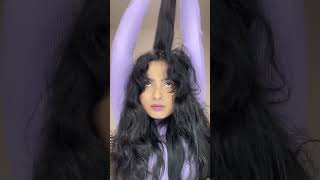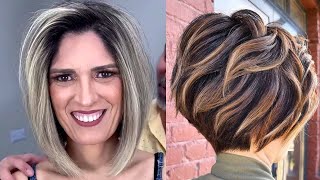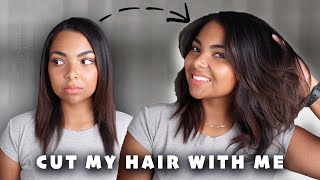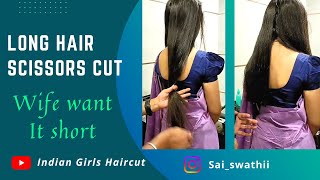Cutting Techniques: Disconnected Layers | Quick Long Layered Haircut Tutorial For Women
- Posted on 02 September, 2021
- Long Hair
- By Anonymous
Learn How to cut Disconnected layered & Long Haircut
Share the best and simplest cutting technique. Learn how to cut best hair.
"I Love Haircut - I Love Hairstylist"
So i have a free hour because it just randomly happened, so i'm going to show you guys how to do a disconnected concave layer like a two-tiered concave uh, which is something that you can do to remove weight. Add a lot of softness. Add a lot of movement without having to do too much texturizing we're going to do all straight lines on this and you're going to get a really soft result just because of the angles and the elevation that we use in the disconnection that we throw in there. So the end result i'm going to end up putting on my page later, but you can watch the entire cut at least see the wet results right now. So you can see we have two different sections here: we've got a top panel, that's kind of like the low crown area forward, and then we have the crown down. This is going to be where one layer is here's another layer. This is really only meant for people who have exceptionally thick hair, be mindful. If there's not enough hair in this section, you need to drop it down a little bit lower. You need to be enough weight in that section to eventually like veil over the layers. You put here and if you have questions or want to say any ridiculous nonsense, say it on there and chloe will repeat it out loud. Oh, you already had one, but this guy asked if your nipples were pierced. No, oh, my god put another jacket on you creep. It'S fine! It'S just that! Maybe this shirt's a little thin! So people can see it self-taught my life about it anyway. We'Re working concave, which means we're gon na, be working short to long right. So i'm gon na stand on this side, so i can point my fingers down and cut from a shorter length to a longer length. We'Re gon na have vertical sections here: everything's gon na be held square back, so we're not following the shape of the head. We'Re just pulling everything straight to the wall, just like that you can tilt down a little bit if you need to, but keep in mind that if you tilt down you got to make sure your elevation is high enough. You don't get a weight line at the top first thing: we're going to do is take a vertical section right here, center back just a very center back of the head right. There don't take it too thick. You see it's just like a little half an inch or so in this case, let's say that we already cut our perimeter. You'Ve already established your length, so we're going to lift this up literally, like all the way up like this, so you can see that's the length right there like this little piece of hair that shortest bit as long as we don't cut that we know that we Still have our perimeter line saved so as long as you don't break that perimeter you're not going to get a hole. So again we're going to come up. I'M going to angle my fingers down and then we're going to cut short to long like this, using our fingers as a platform, so you can see what will happen when you bring this down again, you get a short length that blends all the way down to This longer length, so you get that perfect, cascade and blend of a layer, and it's going to remove a lot of weight from the inside and from the perimeter. So you get that kind of softer feeling what now oh, nothing. Apparently, that was from some guy named mario there's, like friend of mine, doing it, and that means uh yeah. They are not just kidding they're, not horrible, the pain associated with that all right. So again we want we're not going to follow the shape of the head. We'Re just going straight back up to the center, just straight back, you're, going to use a little bit of um your previous section. As a guide, i like to put my fingers in like right behind the comb like that, so i can follow the comb up and that way i get a nice clean guide that i can follow and again we're going to cut short to line like that. If you want to you, can you know, i know that i've already basically cut everything. We can recall one more time if we need to you want you can check to see where those layers are falling. We got a layer, that's about that short. That is blending. All the way down to these bottom links right now, still vertical sections square back, so straight back. Try not to pull too far, it'll start getting too heavy in the corner, and the idea is that we want to really break this weight up a bit. So that's why we're going straight back to save some weight in the corner, but not too much because of the angle that we're using being so short to long so dramatic, like that, it's going to give us a really sort of soft result. Let'S say that you're doing it and all of a sudden, this person didn't have a lot of weight in the corner. For some reason, they just had a little gap of weight there on their head. You could disconnect this and just leave it out and just lay it through here. So remember: it's not like don't be too cookie cutter with this. If you have somebody that has density issues in certain areas, you can adjust what you're doing to compensate for that. So vertical sections again not to the center, just straight back, just like that we're going to come straight up, i put my fingers down, i'm looking for my guide, which is right there and then we're going to cut short to long and we'll have one more section. Think about it like, if you put the comb right here and angle, it straight back you're making that flat wall right there. Oh here's chris we're working in his room right now, so he's peeking through you can tell he's a barber because of his mustache. Oh chris, you should show off these new clippers that we got on the show yeah what they're not ready, yet, maybe they're not ready. The cookers are fine. They aren't ready, oh they're, not ready to see yeah. We'Ve got a secret custom, clipper custom clipper, set that we designed for the crisp design that we just came out with we'll show you guys soon, all right so there's the the layer is in so we get softness and movement. We have these shorter layers in here and it takes all that weight out of the perimeter and out of the inside, to get a really soft result. Now, on the opposite side, here we're going to do the same thing, but i'm going to stand on the same side, because i want to keep pointing my fingers down. If i switch sides, it's going to be too difficult to go short long, and i want to you know, make this as easy as possible for myself to do so. We'Re going to lift this up, follow this straight up. This hair is very dry, so the coat doesn't want to go through it that well so it's shorter to longer and the elevation exaggerates that so you get that really nice drop in length at the bottom. Someone asked what toner we used on the anakin this mannequin actually just has. I think it's a nine silver yeah. It was nine silver from uh colorants chloe. Did it goldwell colorado, nine silver? Okay, here's our next one right here, our last one. So you can see my last panel i'm going to bring it back so that it's straight back not to the center just square back straight back, just like that. We'Re coming up, i'm looking for my guides, we're right there in my finger and i'm going to cut on my fingers like place your scissor on your fingers. So you can work with just your thumb and cut a nice clean line that way, and that is a great way to take out a lot of weight on the inside of a haircut without doing a lot of texturizing. Because now we can drop the top and do a separate layer through the top. But the idea is that, like you have this piece here and you want this to still like fall over it, so it kind of intermingles together so bring that up. We'Re just thinking about natural fall where all this wants to fall vertical section. You can see, look, there's the there's the layer that we got before right in there. So we don't want to connect to that we're going to disconnect so we're going to come up. Come past that layer, so there it is, you can see it in there that shortness we're going right past that you can see, there's already a bit of a layer in here, probably hurting, maybe from class or something like that before and then we're going to drop. That out, so it's just a completely separate concave layer. This one we're going to rotate around. We have a traveling guide with this one because we're not so stressed about the corners. I want to get more of a balanced weight in this, so coming up angling down. Oh, you can see we already have a bit of a concave in here, so this is going to be nice, not a whole lot to cut we're just going to connect all that stuff together right there, each section. I turn the doll a little bit because i have a traveling guide, so i need to travel with the guide as i go. If i don't turn the doll i'm going to start over directing too far, and it's going to give me something that is a little bit longer and heavier in areas that i don't want it to be, there's all sorts of different ways that you can use your Your scissor, that's a pretty fun way to do it so again, vertical over direction only to the previous section, so i'm not pushing it all the way back, i'm basically lifting it straight up from where it sits angling, my fingers down again and again we're just going To start, you know working that short to long just like that. Here'S our last section in the front because there's a little less weight in the front of the face a lot of time i'll over direct this a teeny bit more. Unless you want to have some face framing you don't have to worry about it, you can frame it out later. So there's our guide and we're just going to cut right along that edge, and this is the fancy scissor, the five and a half inch fancy. It comes out on sunday if you want to follow fancy scissors on instagram. You can see when all the new releases of everything come out, but this one will come out on sunday, along with a seven inch fancy as well all right. So here is our last panel now we're combing this out vertical section in the back, we're going to use our previous section as a guide. Again, here's ben now hey hello, checking in there. He is you want to join the party, the man, the myth, the legend. I'M looking for my guides and again we're just gon na my next client is here also so i'm sort of going i'm trying to speed through this layer a little bit, but we're not going to sacrifice the quality of this service we're coming up. I'M looking for my guides like there's my guide right in there and then i'm just going to knock that link off to match. Can you see my wrist is bent like this, like you, don't have to do it that way, you can. You can flatten your wrist out and work this way too either way, it's totally fine. If your wrist is bothering you and you feel like you're going to get some carpal tunnel, it might be a good idea not to bend it. I kind of go back and forth between the two because it can be fun to cut that way. But if you do it all the time it might cause you some wrist issues. So here we are in the back down or i'm sorry on the side. Now lifting up looking for my guides and then we're just going to come and knock that link right off have that level of control right, so i can place that and i can just work that line right in you could even do it with your eyes closed. If you have enough control - which i do sometimes on stage and in classes just for fun, just to freak people out, let's do it right now any place here, nice you did it. You hear that there's a there's a five-year-old running around the salon, there's a wild five-year-old! So here's that last section i was talking about instead of pulling right out here, i'm gon na over direct the last section, a teeny bit. It'S gon na give us a teeny bit of face framing a little bit of a shorter layer there around the face, but that way we don't take out too much weight. So we'll pull this up and back i'm looking for my guides, i'm just going to cut that right in and just hear that little little munchkin running you can see what we get side to side and why we call it a concave layer because it's shorter in The center and it gets longer as i go out through the sides, easy way to check it - is to lift up from whatever your part was and see. Are you getting that sort of a concave shape like that, and if you are, then you know you've been balanced, so um. What we'll do now is we'll let this dry and then i'll come back i'll, get the end result and i'll put it in um. My stories and on my page later, i guess, and we're going to save this and put it on my igtv, so you guys can go back and re-watch. It remember. This is a disconnected concave layer, something that is great when you want to remove a lot of weight. Add a lot of movement, but you don't want to do a lot of texturizing. Maybe your clients are afraid of texturizing, maybe you're afraid of texturizing. This can be a great way to get those results without having to





Comments
Regirl75: Where can I see the end result?! I’d love a link!
TheFarkhondeh: I have the same question,where can I see the end result. Thank you for your hair cut class and explanation .
Оксана Опря: I have the same question ♀️ where can i see the result?
William Charles: Good technique! Dude reminds me of vinnie from "entourage ", lol!
academy shoji: خان معنی زیبایی دارد یعنی بزرگ